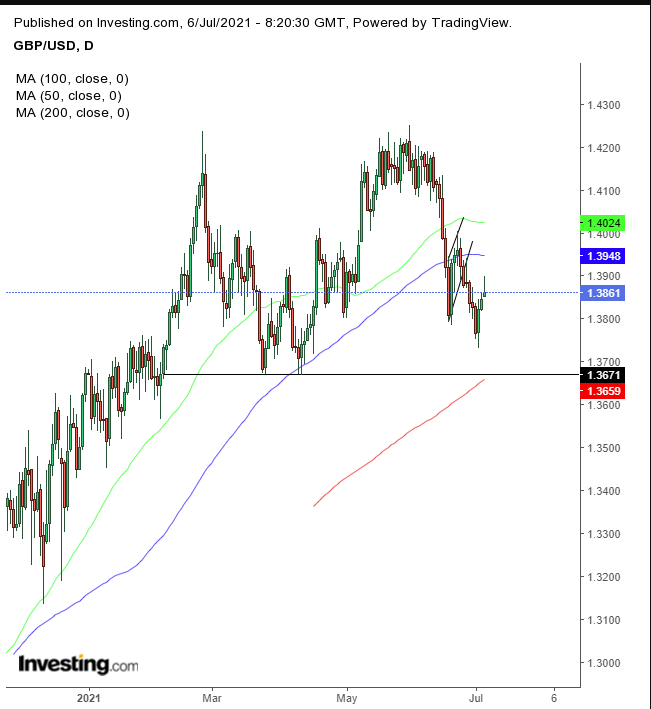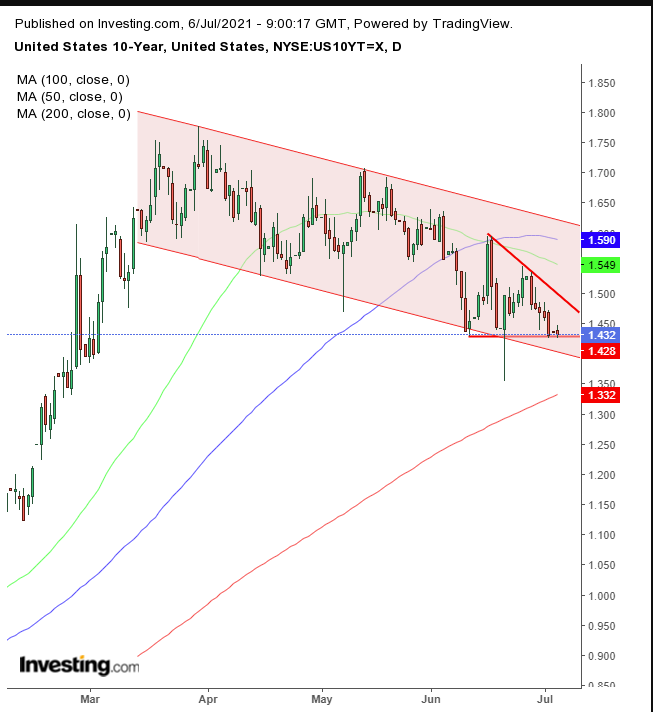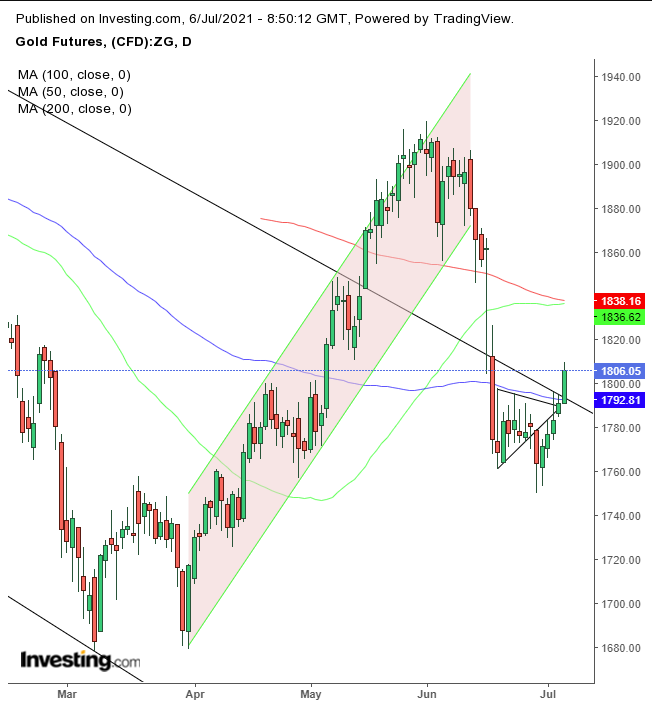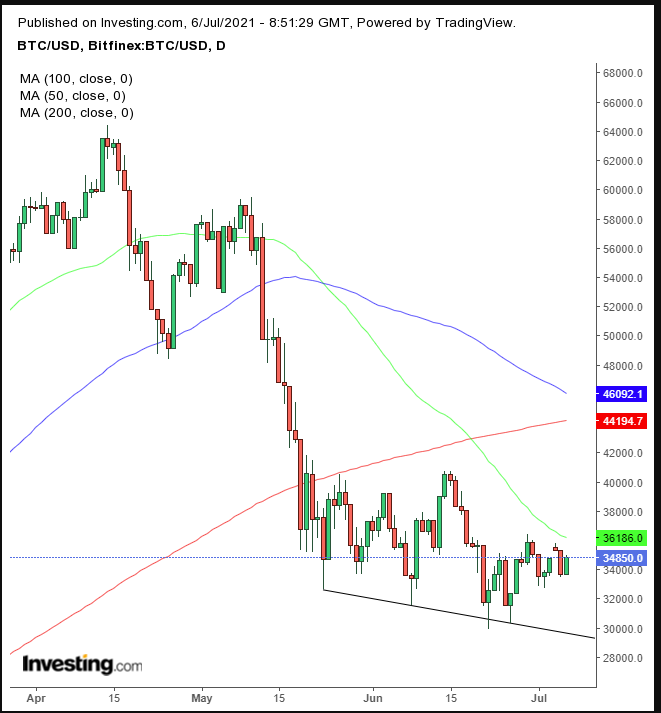- Oil at highest level in 6.5 years
- Gold rally continues
- Bitcoin rallies
- On Thursday, the US publishes crude oil inventories.
- China PPI and CPI data is released on Thursday.
- On Friday, the UK announces its GDP figures.
- The Group of 20 (G20) finance ministers and central bankers meet in Venice on Friday.
- The FTSE 100 fell 0.2%
- The STOXX 600 was little changed
- Futures on the S&P 500 were little changed
- Futures on the NASDAQ 100 fell 0.1%
- Futures on the Dow Jones Industrial Average were little changed
- The MSCI Asia Pacific Index rose 0.2%
- The MSCI Emerging Markets Index was little changed
- The Dollar Index fell 0.2%
- The British pound rose 0.3% to $1.3886
- The euro rose 0.2% to $1.1885
- The Japanese yen was little changed at 110.88 per dollar
- The offshore yuan was little changed at 6.4614 per dollar
- The yield on 10-year Treasuries advanced one basis point to 1.43%
- Britain’s 10-year yield was little changed at 0.72%
- Germany’s 10-year yield was little changed at -0.21%
- Brent crude rose 0.7% to $77.71 a barrel
- Spot gold rose 0.8% to $1,805.72 an ounce
Key Events
US futures on the Dow, S&P, NASDAQ and Russell 2000, as well as European shares, were little changed ahead of the first day of trading after the US holiday weekend as markets wait for the release of the FOMC minutes, scheduled to be published on Wednesday. Treasuries wavered as traders considered the implications of a rising oil price as OPEC+ talks fell apart.
The dollar fluctuated along with yields; gold prices advanced for the fifth straight day.
Global Financial Affairs
US futures were flat after all the major indices, except the Russell 2000, notched records in trading last week.
In Europe, a rally in energy shares offset a selloff in automobile producers, leaving the STOXX 600 Index mostly steady.
Britain plans to ease all social restrictions on July 19 and the announcement boosted sterling, which weighed on the FTSE 100 index, the main market gauge for the export-dependent UK.

The pound pared an advance, forming a bearish Shooting Star (complete upon closing), as the price neared a bearish flag. This pattern is a market spring. After pulling back, it springs in the previous direction, and in this case that is down.
However, the 200 DMA lends its support to the February and March lows, which could turn out to be the neckline of a H&S top, if the 1.36 level provides a support. If not, it could turn into a double-top if the price falls through the 1.36 level.
OPEC+ was plunged into crisis as a deteriorating relationship between Saudi Arabia and the United Arab Emirates resulted in no increase in oil supply. The breakdown of talks has sent crude climbing towards $80 a barrel, but also raises the risk of a price war if the disagreements at the 23-member alliance escalate.
Higher energy costs could fan the inflationary pressures that are adding to the case for the US Federal Reserve to temper emergency stimulus in the months ahead.
The latest US central bank minutes may provide further context about its hawkish pivot last month. The risk of oil at $100 a barrel “is so correlated with short-run inflation that it will make the market very, very edgy, and we know that the Federal Reserve is both watching the economic data, but also markets,” Alan Higgins, chief investment officer at Coutts & Co., said on Bloomberg Television.
Most of the major Asian benchmarks closed lower at the end of a volatile session. Australia’s ASX 200 (-0.75%) underperformed, dragged down by a selloff of highly valued tech stocks after the Reserve Bank of Australia announced at its July policy meeting that skyrocketing oil prices could force it to increase rates, in an attempt to temper inflation. The price of oil has a substantial impact on the economy there and is therefore threatening its recovery.
China’s Shanghai Composite (-0.1%) was the only other major benchmark in the red. Another theme weighing on regional investors’ minds is the pressure that the Chinese technology industry is under after the country’s Cyberspace Administration ordered an investigation into Didi Global (NYSE:DIDI), just days after it listed on the New York Stock Exchange.
The tech industry has been gaining influence in the Chinese market, and a crackdown would test traders’ risk tolerance.
WTI surged following the announcement that the OPEC+ meeting was postponed as members failed to agree to allow the cartel to raise output. Oil prices are on their way to $77, the highest since Nov. 12, 2014.
This has extraordinarily important implications for US inflation, especially ahead of the traditional heightened summer usage of fuel and the substantial increase in travel that is expected due to pent-up demand after pandemic lockdowns restricted consumers' movement.
Also, oil is necessary for most forms of production, something else that increases profoundly during an economic recovery, especially the rapid one that markets are expecting.
Investors are trying to figure out whether rising oil prices will force the Fed to raise interest rates faster that it plans, which would decrease demand for Treasuries, including on the 10-year note, or whether inflation will disrupt the expected economic rebound, which would increase demand for the ultimate haven, US Treasuries, forcing yields even lower.

If yields fall below the descending triangle, they will likely break through the bottom of its current tempered falling channel, testing the 200 DMA.
The dollar came back from a third-day of declines, but that didn’t stop gold from jumping for the fifth consecutive day, blowing out a bearish pennant, cutting through the 200 DMA and climbing over the top of its former falling channel since the 2020 record peak.

The 50 DMA flatted below the still down-pointing 200 DMA, as the averages fizzle out. Perhaps, the Fed minutes will provide a catalyst, which would settle the averages’ indecision.
Bitcoin rallied towards $35,000.

The cryptocurrency has remained within its range since May, which could turn out to be a H&S continuation pattern.
